CARE AND MAINTENANCE OF THE
BATTERY
From the Austin Magazine
1936
THE battery is the "reservoir'
of the energy generated by the dynamo, and upon its satisfactory functioning
depends the starting and running of the car. The battery is really the heart of
your car's electrical system. Just as the human heart supplies blood to the
nerve centres of the body, so the battery distributes the electrical energy to
the starting, ignition, lighting and other electrical equipment. As with human
beings, the battery requires the observance of a few simple rules to keep it
healthy and prolong its life.
Perhaps because the battery does not contain moving
parts and is usually housed out of sight, some car owners are apt to forget that
it needs attention in just the same way as other parts of the car's mechanism.
The amount of attention needed is very small and need take only a few minutes.
Follow the directions given here and your battery will last longer and give
better service.
Topping up the battery
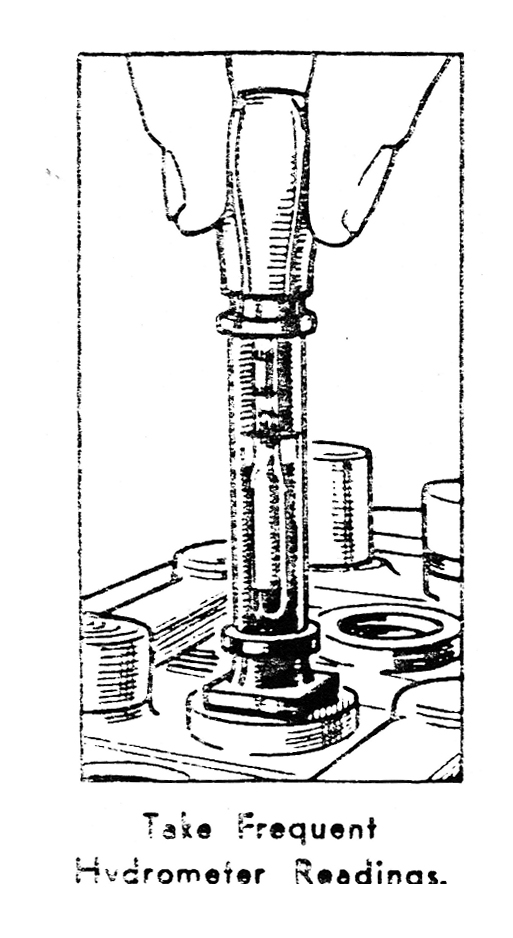 Once
a month unscrew the filler caps and pour a small quantity of distilled water
into each of the cells (the separate compartments of the battery) to bring the
acid just level with the tops of the separators. This is done to replace water
which has been lost by evaporation, and it is just as important as pumping air
into your tyres, or refilling your radiator. In effect, you are doing the same
thing in each case—replacing something which has been lost in service. But
though your engine would soon protest if you forgot to fill your radiator, the
battery has no means of expressing its distress. It just suffers in
silence. That is why it is so important to examine it regularly for, if
the plates are left uncovered for long, they will suffer a chemical change and
be irretrievably damaged.
Once
a month unscrew the filler caps and pour a small quantity of distilled water
into each of the cells (the separate compartments of the battery) to bring the
acid just level with the tops of the separators. This is done to replace water
which has been lost by evaporation, and it is just as important as pumping air
into your tyres, or refilling your radiator. In effect, you are doing the same
thing in each case—replacing something which has been lost in service. But
though your engine would soon protest if you forgot to fill your radiator, the
battery has no means of expressing its distress. It just suffers in
silence. That is why it is so important to examine it regularly for, if
the plates are left uncovered for long, they will suffer a chemical change and
be irretrievably damaged.
You can obtain distilled water from any chemist and
most garages. On no account use tap water, as if contains impurities
detrimental to the battery. In this respect the battery is more fastidious
than human beings! The best method of topping up is to use a hydrometer, an
instrument which looks rather like. an outsize fountain pen filler; and is used
for measuring the state of charge of a battery, or, as it were, finding out the
state of its health.
Remember, it is only the water which evaporates, not
the acid. If you do spill any acid, it should be replaced by sulphuric
acid solution diluted to the same specific gravity as the acid in the cells.
This is measured by the hydrometer.
Keeping it clean
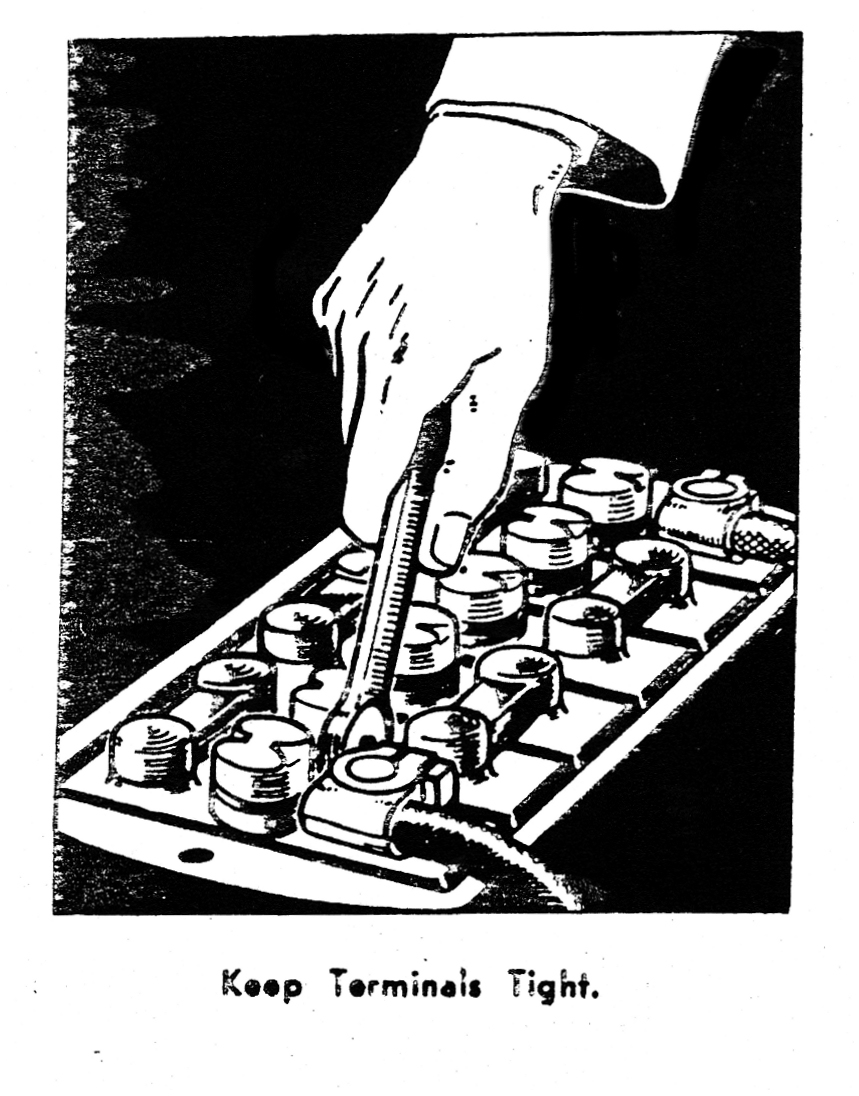 Keep
the terminals and battery fixing bolts clean, tight and well-smeared with
Vaseline. A liberal smearing of Vaseline protects them from the corrosive action
of the acid which, if allowed to continue unchecked, will eventually result in
trouble. So, do not forget the Vaseline!
Keep
the terminals and battery fixing bolts clean, tight and well-smeared with
Vaseline. A liberal smearing of Vaseline protects them from the corrosive action
of the acid which, if allowed to continue unchecked, will eventually result in
trouble. So, do not forget the Vaseline!
With earth return equipment, one of the terminals must
be in good electrical contact with the chassis. When inspecting the battery, put
a spanner on the bolt securing the cable end to the chassis to make sure it is
quite tight.
Keep the outside of the battery clean and dry,
particularly the tops of the cells. Water and dirt form quite a good conductor
of electricity and, if such a path is allowed to form between the positive and
negative terminals of the battery or between a terminal of the battery and the
chassis, there will be a leakage of current which will cause the battery to run
down. Give the cell tops a regular wipe over and you will avoid this.
Regular servicing
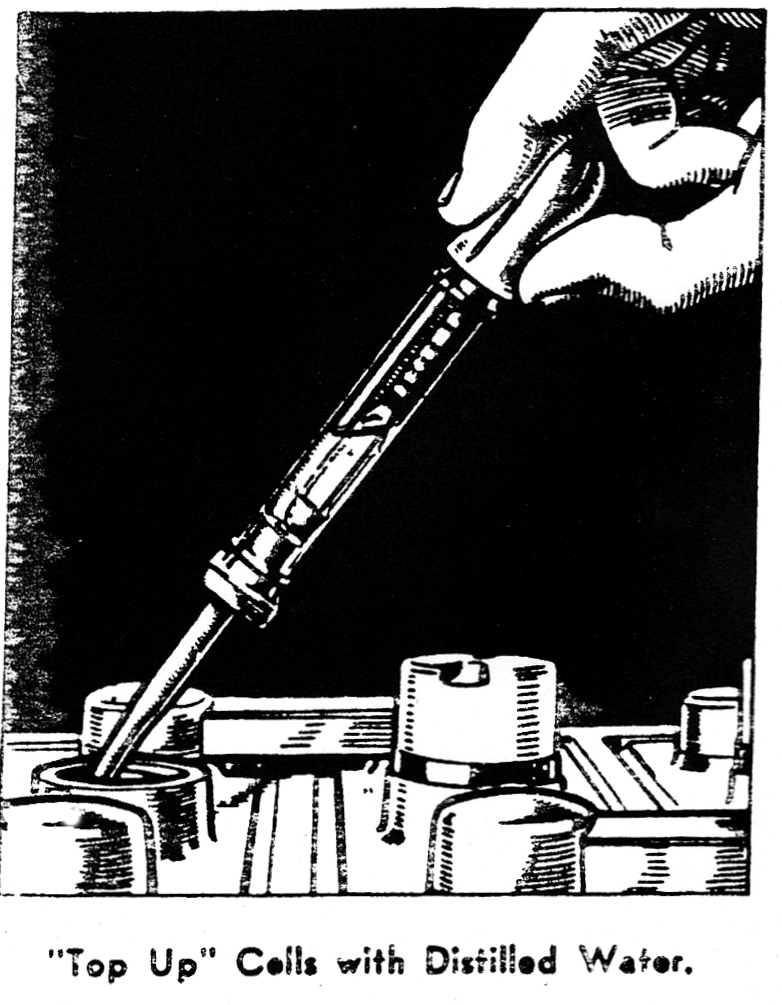 Once
a month make a point of examining the health of your battery by taking
hydrometer readings. This operation is quite simple and need not take long.
There is no better way of ascertaining the state of charge of your battery. This
instrument, enables you to "take a sample" of the acid solution. It contains a
graduated float which indicates the specific gravity of the acid in the cell
from which the sample has been taken.
Once
a month make a point of examining the health of your battery by taking
hydrometer readings. This operation is quite simple and need not take long.
There is no better way of ascertaining the state of charge of your battery. This
instrument, enables you to "take a sample" of the acid solution. It contains a
graduated float which indicates the specific gravity of the acid in the cell
from which the sample has been taken.
The specific gravity readings and their indications
are as follows:—
1.250 -
1.300—Battery fully charged.
1.150 -
1.250 - Battery about half discharged.
Below
1.150—Battery fully discharged.
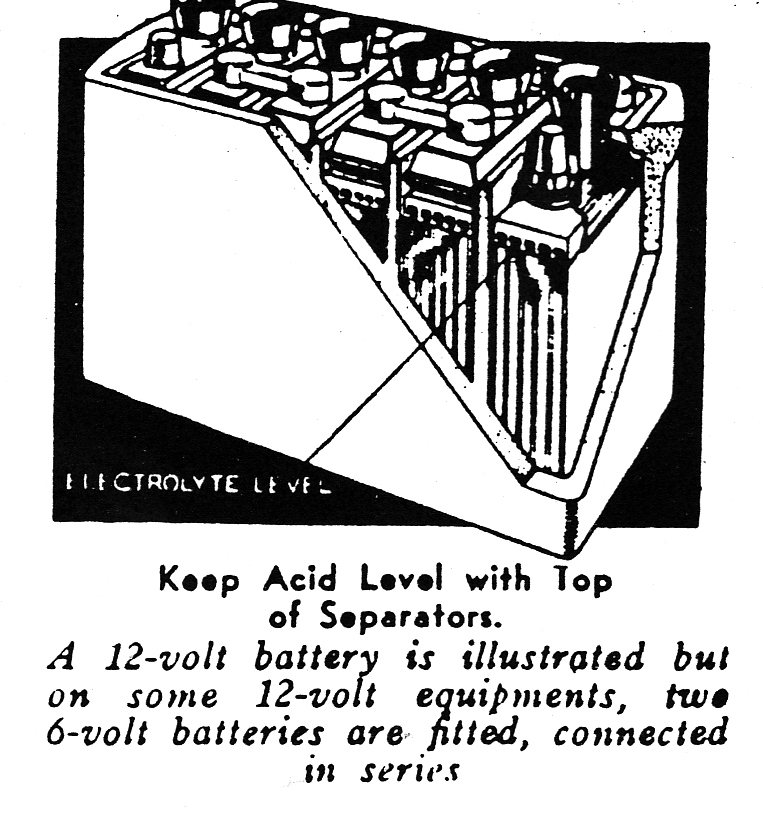 These
figures are given assuming the temperature of the solution is about 60oF.
These
figures are given assuming the temperature of the solution is about 60oF.
The readings for each of the cells, (there are six
cells in a 12-volt battery, and three in a 6-volt type) should be approximately
the same. If one cell gives a very different reading from the rest, it may be
that acid has been spilled or has leaked from this particular cell, or there may
be a short circuit between the plates. In this case, we advise the owner to have
his battery examined by a Lucas Service Depot—neglect may mean costly repairs
later on.
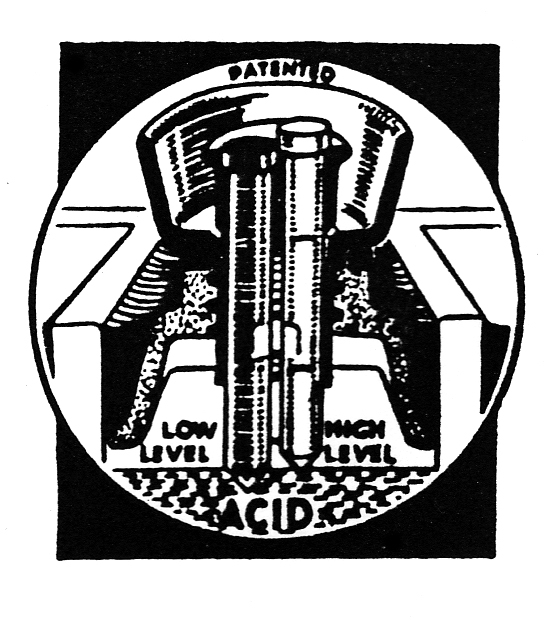 Combined
AcidLevel Indicator, Vent Plug and Filler Cup (when fitted).
Combined
AcidLevel Indicator, Vent Plug and Filler Cup (when fitted).
The indicator consists of two small glass rods which
project into the top of the cell. When the acid level is low, the tops of both
rods appear light. "Top up" the battery by pouring distilled water slowly into
the filler cup until both indicators just go dark—then stop.
KEEPING THE BATTERY
CHARGED.
It must be remembered that you cannot get more energy
out of the battery than is put in. If the car is left parked at night with the
lights on, or if the starter motor is used excessively with very little daytime
running, then the battery may get in a low state of charge — particularly in
winter. This may be remedied either by running the car for longer periods during
daytime or by economizing in the use of the head lamps and other accessories. If
this is not possible, have the battery recharged from an independent electrical
supply.
Never leave the battery in a discharged condition for any length of time. This
is very bad for it. In a sense, it is like running a car on flat tyres. If the
car is to be out of use for any length of time, see that the battery is fully
charged and about every fortnight give it a short refreshing charge to prevent
any tendency to permanent sulphation of the plates.The battery being the
"reservoir" for the energy generated by the dynamo, once it is full, there is no
object in delivering further current to it. While it is always better to keep a
battery overcharged rather than undercharged, it should be remembered that
extremes of undercharging or over-charging will tend to shorten the life of the
battery.
Obviously, the amount of charging required will depend
on how you use the car. If it is used for short runs in town, with
consequent frequent use of the starter, the battery will naturally require more
charging than when it is used for long distance runs. Then again, the demands on
the battery are generally greater in winter than in summer — the lamps are more
frequently used and the starter takes more current when turning over a cold
engine.
In order to cater for these varying demands, the
dynamo is arranged to give alternative outputs.
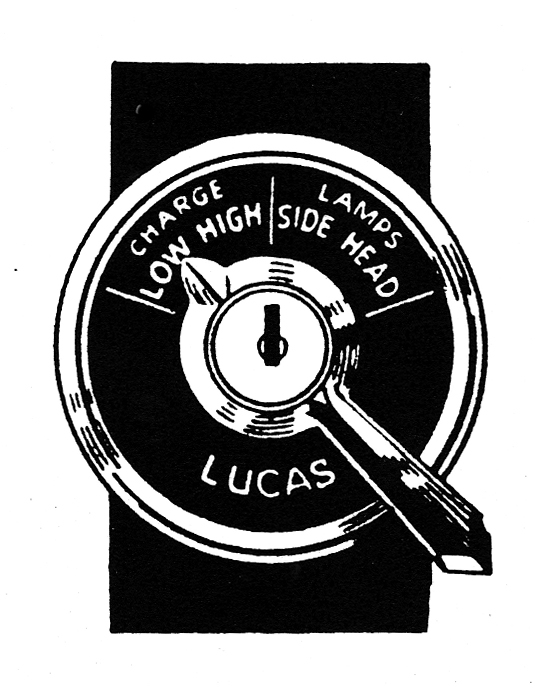 How
to Use the Charging Switch.
How
to Use the Charging Switch.
This switch is mounted either at the centre
of the steering wheel or in the instrument panel. It has two
positions—usually marked "LOW CHARGE" and "HIGH CHARGE" or "SUMMER" and
"WINTER". The dynamo is arranged to give its maximum output whenever the head
lamps are switched on. For cars running under average conditions, keep the
switch in the "LOW" position during summer and in the "HIGH" position during
winter. In some cases, where exceptional use is made of the lamps and
starter in the summer, causing the battery to be in a low state of charge
(hydrometer readings of 1.200 or under), run with the charging switch in the
"HIGH" position. On the other hand, if in winter the battery is being
over-charged, shown by the hydrometer readings of 1.250 - 1.300, the need for
very frequent "topping up," or repeated burning out of bulbs, then move the
charging switch to the "LOW" position.
What to do if the
battery does not keep in a charged condition.
If the battery is found to be in a half
discharged or lower state of charge, the charging switch should, if possible, be
left in the "HIGH" position for longer periods of running. It should be
remembered that the battery will be helped to regain its normal condition if its
load is temporarily lessened, as for instance, by using the side instead of the
head lamps. If the condition of the battery does not improve in a reasonable
time, it is advisable to have the battery inspected at a Service Depot.
The battery must never be left in a fully discharged
condition, and unless some long runs are to be taken, it is advisable to have
the battery charged up from an independent electrical supply.
To Owners of New Cars.
If you have just taken delivery of a new car,
we advise you to keep the switch in the "HIGH" charge position all the time
during the runningin period, in order to compensate for the heavy load of the
starter motor due to the initial stiffness of the engine.
 Once
a month unscrew the filler caps and pour a small quantity of distilled water
into each of the cells (the separate compartments of the battery) to bring the
acid just level with the tops of the separators. This is done to replace water
which has been lost by evaporation, and it is just as important as pumping air
into your tyres, or refilling your radiator. In effect, you are doing the same
thing in each case—replacing something which has been lost in service. But
though your engine would soon protest if you forgot to fill your radiator, the
battery has no means of expressing its distress. It just suffers in
silence. That is why it is so important to examine it regularly for, if
the plates are left uncovered for long, they will suffer a chemical change and
be irretrievably damaged.
Once
a month unscrew the filler caps and pour a small quantity of distilled water
into each of the cells (the separate compartments of the battery) to bring the
acid just level with the tops of the separators. This is done to replace water
which has been lost by evaporation, and it is just as important as pumping air
into your tyres, or refilling your radiator. In effect, you are doing the same
thing in each case—replacing something which has been lost in service. But
though your engine would soon protest if you forgot to fill your radiator, the
battery has no means of expressing its distress. It just suffers in
silence. That is why it is so important to examine it regularly for, if
the plates are left uncovered for long, they will suffer a chemical change and
be irretrievably damaged. Keep
the terminals and battery fixing bolts clean, tight and well-smeared with
Vaseline. A liberal smearing of Vaseline protects them from the corrosive action
of the acid which, if allowed to continue unchecked, will eventually result in
trouble. So, do not forget the Vaseline!
Keep
the terminals and battery fixing bolts clean, tight and well-smeared with
Vaseline. A liberal smearing of Vaseline protects them from the corrosive action
of the acid which, if allowed to continue unchecked, will eventually result in
trouble. So, do not forget the Vaseline! Once
a month make a point of examining the health of your battery by taking
hydrometer readings. This operation is quite simple and need not take long.
There is no better way of ascertaining the state of charge of your battery. This
instrument, enables you to "take a sample" of the acid solution. It contains a
graduated float which indicates the specific gravity of the acid in the cell
from which the sample has been taken.
Once
a month make a point of examining the health of your battery by taking
hydrometer readings. This operation is quite simple and need not take long.
There is no better way of ascertaining the state of charge of your battery. This
instrument, enables you to "take a sample" of the acid solution. It contains a
graduated float which indicates the specific gravity of the acid in the cell
from which the sample has been taken. These
figures are given assuming the temperature of the solution is about 60oF.
These
figures are given assuming the temperature of the solution is about 60oF.
 Combined
AcidLevel Indicator, Vent Plug and Filler Cup (when fitted).
Combined
AcidLevel Indicator, Vent Plug and Filler Cup (when fitted). How
to Use the Charging Switch.
How
to Use the Charging Switch.